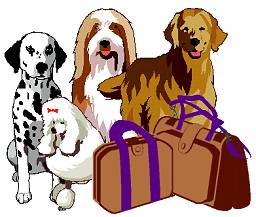Air Travel Tips

Traveling with pets doesn't have to be a nightmare.
Here are some thoughts from our staff (who have shipped a LOT of pets
both internationally as well as domestically).
Buy an adequate, airline-approved carrier. Vari Kennels are all airline approved although some international carriers will require that you drill holes in the back side of the carrier as well as have the usual ventilation on the front and sides. It's not hard to do.
Sky Kennels are
sturdier and include ventilation holes wherever they are needed - no
drilling required.
Pets cannot ship in see-through metal kennels. They'd feel
more anxiety in those, anyway. The less they see the better they
like it.
Many airlines require that the crate be tall enough for your
dog to stand up in a natural manner ie: the total height of the
kennel be equal to or taller than the total height of the dog.
However, if it is too large, he can be thrown from side to side
and possibly injured more easily than if he is in a crate that
is just right.
Purchase your carrier at least two weeks before travel so your pet has time to get used to it. Give him chew treats and positive experiences at home so he enjoys his time in the crate.
Most travel requires a valid rabies certificate (within 1 month to
1 years depending on your destination) and a veterinary health
certificate within the past 10-30 days (again depending on the
destination). The airlines should be able to give you this
information. If you can't get it from them, call the consulate of
the receiving country.
Some countries and US States have long, arduous, and expensive
quarantine. Hawaii, Great Britain, Australia, and other
countries have up to 1 year.
Pets don't travel well on a full stomach. Take away all food at
least 12 hours prior to travel and water 4 hours before travel. (If
you'd like him to have a small amount of liquid to 'wet his
whistle', fill his water cup with water and freeze it. It will melt
over travel time and give him a small drink without spilling.)
He can also have a natural bone or rawhide chew to keep him busy
during the flight. Send a snugly toy with a young or particularly
social pup.
If your pets are high strung or nervous, there are a couple of all-natural calmatives or tranquilizers that might help. You want him to be just drowsy, not asleep. Cats don't travel as well as dogs sometimes. However, if you are going to use a calmative or tranquilizer, experiment with it BEFORE you travel to be sure what the effect will be. Cats sometimes react just the opposite of the way you would expect.
If your pet will be traveling in the airline cabin with you, try to exercise outside the airport before check-in and between flights. Don't feed during the trip although a SMALL amount of water may be OK if the pet will be allowed to relieve himself at least every 3-4 hours. Take paper towels or other clean-up materials in case he has an "accident" inside the airport. Take a bottle of his home-bottled water.
If the pet is Traveling in the cargo section, it is best if you
arrange for counter-to-counter service so you can check him in and
pick him up at the ticket counter with your luggage. If he is
Traveling without you, you will probably have to leave him at the
Cargo area, but you should ask if you can drop him off at the
luggage counter.
Expect that you will need extra time for drop off or check in
and be prepared.
You can also expect that he may be sitting on the tarmac for
an hour or more before he is loaded into the belly of the plane
and after he is unloaded.
The airline personnel will NOT open your dogs crate for any
reason. If you want them to water him during the flight (not
much we hope), then use the cups that come in the air travel
package purchased at the same time you purchase the crate. They
can stick the snout of a water can through the door mesh and
fill his bowl.
We feel it is better to affix a water bottle to the inside of
the crate door with a few ounces of home water for your pet to
lap during the flight. That way you can give him a little
moisture but can control that he doesn't get so much that it
fills his bladder and makes him uncomfortable.
The cargo area of the plane where you pet travels is temperature
and pressure controlled, much like the cabin. He will be fairly
comfortable. It's the beginning and end of the trip or during
changes of planes that are the most stressful.
Choose a direct flight if at all possible! We can't stress
this enough. Especially if he is Traveling without you, changing
planes can be fraught with disaster--especially in airports as
large as Dallas-Ft Worth. Try to avoid any changes.
Pets are not allowed to travel when the temperature at either end of their journey is too high or too low. This makes travel safer, but can be inconvenient in Summer or Winter in some parts of the world. Plan way ahead.
Most airlines don't seem to like to handle pets, no matter what they say. You must have your "ducks in a row" and do most of the work for them. If you're prepared, both you and your pets will be more comfortable, and you'll minimize anxiety, frustration, and airline mistakes.